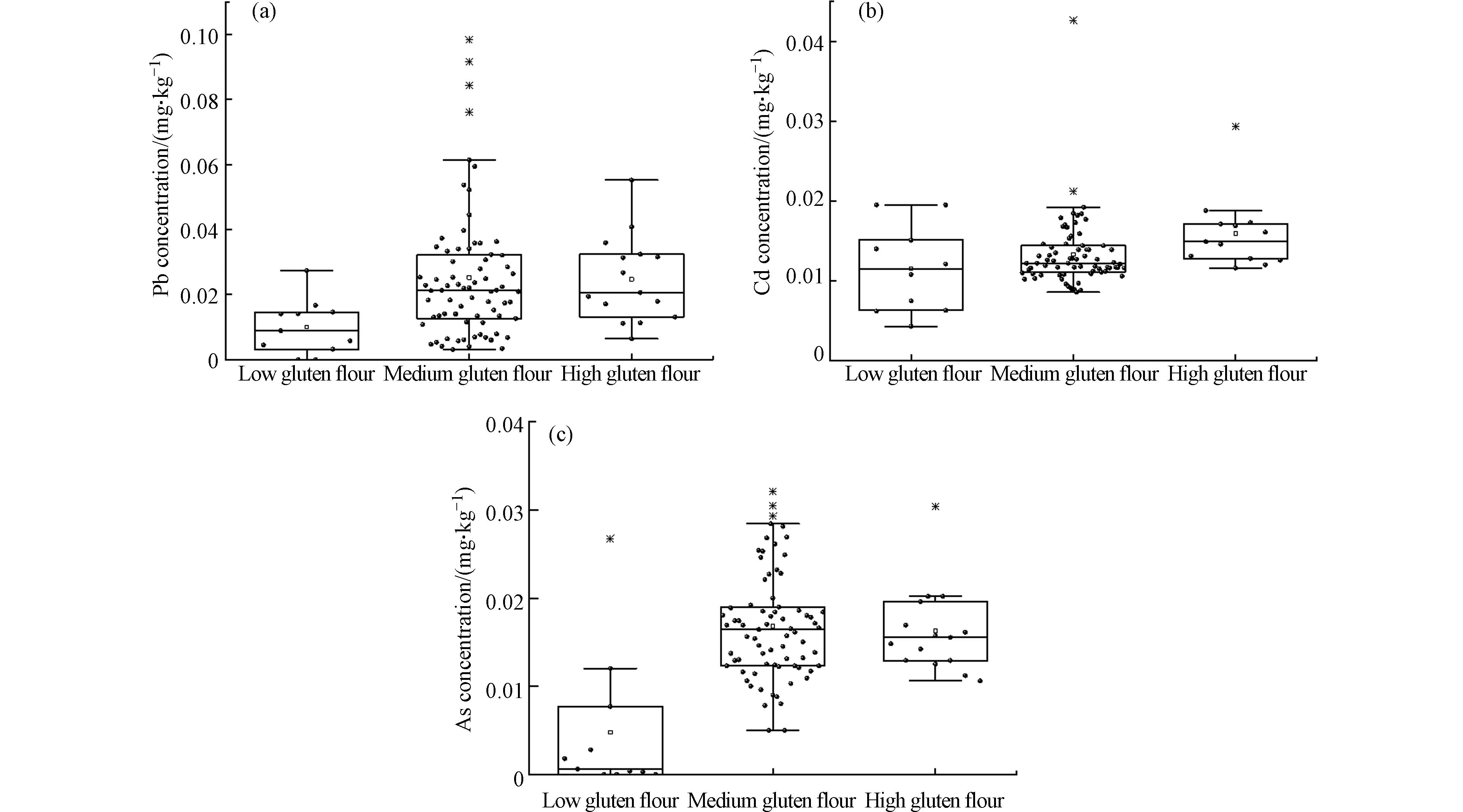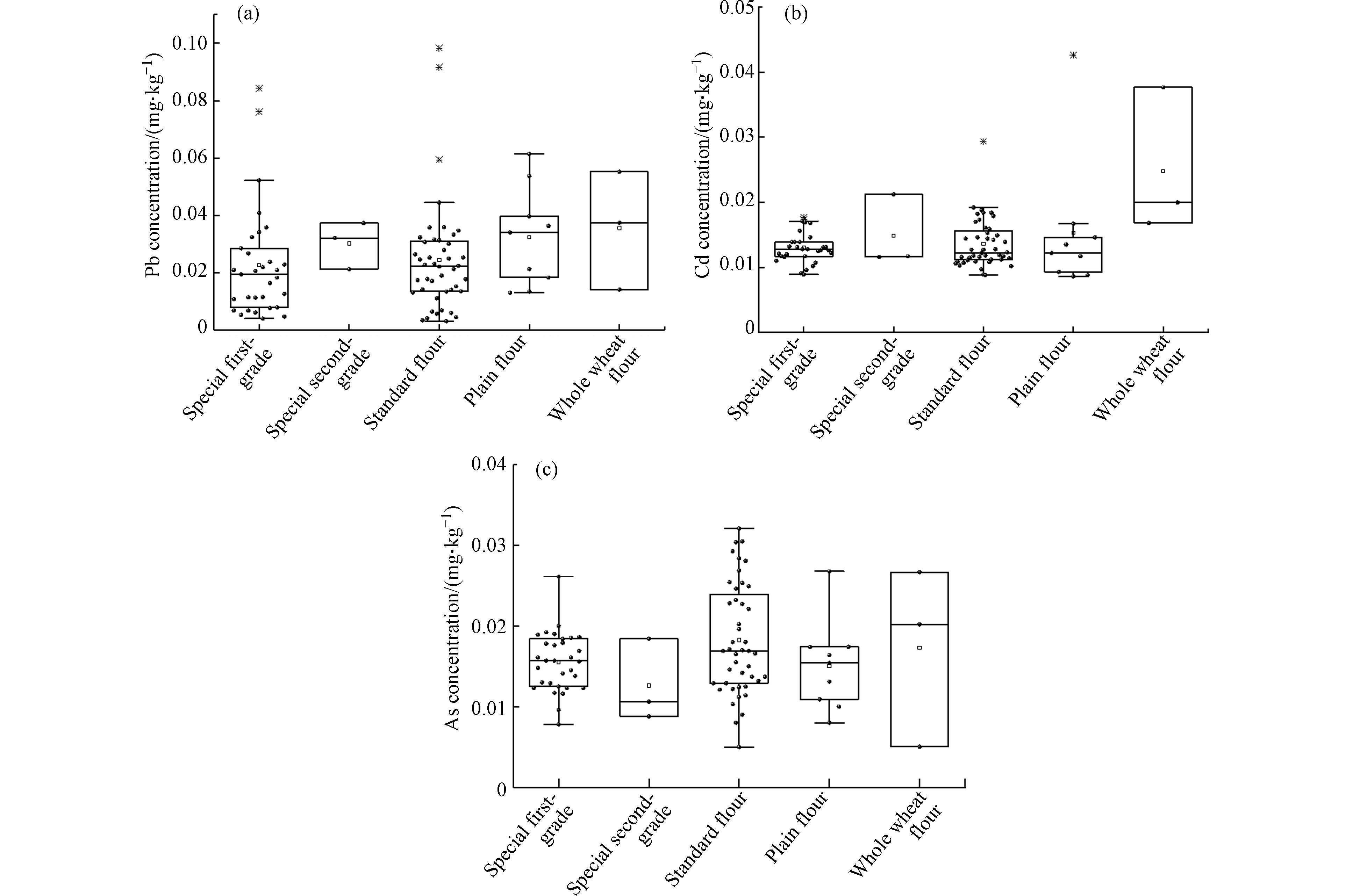-
小麦是我国乃至全世界主要的粮食作物之一,是全球一半以上人口的食物来源,全球年产量达7.5亿t[1−4]. 河北省位于黄淮海平原,属于温带-暖温带、半湿润-半干旱大陆性季风型气候,是我国粮食主产区. 据统计,2021年河北省小麦种植面积达2.25×106 hm2,占我国小麦总种植面积的9.53%[5]. 然而由于污灌、三废排放等,农田土壤重金属污染问题日益严重,导致局部地区小麦籽粒中重金属含量超标. 天津市某污灌区小麦籽粒重金属Pb、Cd、Cu和Cr均有不同程度超标,其中小麦籽粒Cd超标问题最为严重,超标率高达90.82%[6];雄安新区企业周边农田调查结果表明,小麦籽粒重金属Pb和Cd的超标率分别为96.67%和16.67%[7];河北省保定某污灌区土壤Cd点位超标率高达48%,小麦籽粒中Pb、Cd和Hg含量超标率分别为24%、3%和3%,虽然籽粒As含量不超标,但是其具有较高的健康风险,所以粮食中As对人体的潜在健康风险也不容忽视[8]. 有研究对近10年发表的56篇有关小麦籽粒重金属超标问题论文进行Meta分析,结果表明,农田样点Cd超标率为52.6%,小麦籽粒Cd含量超标率高达64.1%[9]. 调查研究表明,我国粮食主产区之一的黄淮海平原耕地土壤重金属点位超标率达12.2%[10],其中谷类作物的重金属累积超标现象主要出现在污灌区,污染物平均超标率达18.5%[11]. 因此,小麦作为我国北方的主粮[12−16],籽粒重金属污染已经成为制约粮食安全生产的重要问题.
小麦籽粒不同部位重金属的分布特征不同. 有研究表明,Pb主要积累在小麦的麸皮部位,去除籽粒麦麸(质量占比5%)和糊粉层(质量占比10%)后,Pb含量可分别降低53.73%—60.74%和72.84%—76.85%;Cd主要累积在中心胚乳中,去除麸皮后籽粒Cd含量仅降低20.30%—23.98%[17]. 研究表明,Cd和Se更容易与S元素结合[18],因此相比于其他元素更容易在胚乳中积累. 有研究采用激光剥蚀-等离子体质谱仪(LA-ICP-MS)、X射线荧光光谱(XRF)和纳米离子探针(NanoSIMS)等技术原位探测元素在作物籽粒的分布,发现Pb主要分布在麸皮中,As主要以蛋白质结合形态存在于淀粉胚乳中[2,19−21]. 近期有研究通过分层磨粉技术发现,Pb主要分布在种皮和糊粉层,占籽粒总量的57.54%,而Cd和As主要分布在中心胚乳,分别占籽粒总量的69.42%和67.70%[22]. 重金属在小麦籽粒不同部位的分布与其存在形态有关,因此,研究重金属在籽粒不同部位的分布对小麦面粉安全加工具有重要的指导意义.
小麦籽粒主要由皮层、胚乳和胚组成,其中皮层占籽粒重量的11%—15%,胚乳占籽粒重量的80%—85%,胚约占籽粒重量的3%[23]. 小麦籽粒制粉是将小麦籽粒的皮层与胚乳分离,并把胚乳研磨成粉,或经过配粉等处理,制成各种不同等级和用途成品的过程[24],而小麦籽粒在加工和研磨过程中除去皮层、糊粉层和胚芽的程度称为小麦的加工精度. 全麦面粉和普通面粉加工精度最低,麸皮含量较高. 研究表明,当前面粉加工工艺包括皮磨、渣磨、心磨和尾磨4 个系统,皮磨系统是将小麦胚乳和麦麸分离,心磨系统是将其它系统获取的胚乳研磨成小麦粉[25]. 制粉过程中,随着面粉加工精度的提高,出粉率随之降低,混入面粉中的麦麸越少[26]. 由于重金属Pb、Cd和As在籽粒麦麸、糊粉层和胚乳等不同部位分布存在差异[19−21],可能导致不同加工精度面粉重金属含量存在差异. 有研究通过分析小麦不同粉路产品中Pb和Cd含量,发现粗麸皮(片状麸皮)Pb含量显著高于细麸皮(颗粒状麸皮),皮磨粉和心磨粉Cd和Pb含量没有显著差异[27]. 但是市售面粉中不同加工精度重金属分布特征尚不清楚. 此外,面粉的面筋含量不同,其用途不同[28],蛋白质组分也不同,而研究表明,籽粒中重金属分布与蛋白质组分紧密相关,Pb和Cd容易与球蛋白和谷蛋白结合[29],其中球蛋白主要分布在小麦糊粉层、胚和种皮,谷蛋白作为面筋蛋白的主要成分,主要分布于胚乳中[30],与面粉筋力呈极强的正相关性[31]. 也有研究表明,水稻籽粒胚乳中的蛋白质中存在α-螺旋结构,富含分子间二硫键[32],因此可能是重金属As的潜在结合位点. 由此可见不同筋力面粉重金属含量同样可能存在差异.
本研究通过对河北省保定市售面粉重金属Pb、Cd和As含量进行测定,通过分析不同筋力、加工精度面粉中的重金属含量特征,明确河北省保定市售面粉重金属Pb、Cd和As含量特征,开展健康风险评价,以期为小麦安全加工和生产提供依据.
-
2023年2月—3月于保定市各大超市、面粉厂采集小麦面粉样品共100份,其中面粉产地为河北省的83份,包括:沧州16份、保定19份、廊坊12份、石家庄10份、邢台9份、邯郸7份、唐山6份、张家口2份和承德2份;外省的面粉样品17份,其中北京4份、山东7份、河南3份、吉林1份、上海1份和江苏1份. 其中高筋面粉样品15份,中筋面粉样品74份,低筋面粉样品11份. 面粉按照加工精度进行分类,其中特制一等面粉、特制二等面粉、标准面粉、普通面粉和全麦面粉分别为31、3、44、9、3份,10份样品未标注加工精度. 每份面粉样品随机取20 g左右,于烘箱65 ℃烘干,干燥密封放于4 ℃冰箱保存,待测面粉样品Pb、Cd和As含量.
-
称取0.5 g左右面粉样品,采用HNO3-H2O2(5:2,体积比,国药集团化学试剂有限公司,优级纯)消解,消解后使用电感耦合等离子体质谱仪(ICP-MS)(PerkinElmer公司,NexION350X,USA)测定面粉中Pb、Cd和As的含量[33−34]. 面粉样品以小麦粉标准物质(GBW(E)
100493 )进行准确度和精密度控制. 并同步分析空白样品以去除试剂干扰,其中Pb、Cd和As的回收率为85%—115%(Pb、Cd和As的方法检测限分别为0.02 μg·g−1、0.002 μg·g−1和0.002 μg·g−1),符合质量控制要求. -
根据《食品安全国家标准 食品中污染物限量》(GB
2762 -2022)[35]标准,谷物碾磨加工品重金属Pb、Cd和As的限量标准分别为0.2 mg·kg−1、0.1 mg·kg−1g和0.5 mg·kg−1. -
根据EPA综合风险信息数据库(IRIS)和国际癌症研究机构(IARC)的相关研究成果,污染物可分为致癌物质和非致癌物质,其中Cd和As属于致癌性物质,Pb属于非致癌性物质.
农作物摄入途径下日均暴露量ADDi计算公式为:
化学致癌物风险评价模型,其表达式为:
式中,Ri为化学致癌物质i所致个人致癌年风险,a−1;Ra为总致癌物所致个人致癌年风险,a−1;ADDi为化学致癌物质i的日均暴露剂量,FAO/WHO联合食品添加剂专家委员会(Joint FAO/WHO Expert Committee on Food Additives,JECFA)制定镉的 PTMI 为25 µg∙kg−1[39],As暴露的参考剂量为3×10−4 mg·(kg·d)−1[40];SFi为化学致癌物质i的致癌强度系数,Cd为6.1,As为1.5,70为平均寿命.
化学非致癌物风险评价模型,其表达式为:
式中,Ri为化学非致癌物质所致个人致癌年风险,a−1;Rb为总非致癌物所致个人非致癌年风险,a−1;ADDi为化学非致癌物质i的日均暴露剂量,mg·(kg·d)−1;RfD为化学非致癌物质暴露的参考剂量,Pb暴露的参考剂量为3.5×10−3 mg·(kg·d)−1[40],70为平均寿命.
EPA规定人体对重金属污染可接受的风险水平R总在10−6—10−4 a−1之间,当R总<10−6 a−1时,表示对人体健康无风险;当10−6<R总<10−4 a−1时,表示有风险,人体可接受风险水平;当R总>10−4 a−1时表示有较显著风险.
-
采用Microsoft Excel 2016和Origin 2022进行数据分析以及制作图表,SPSS 24.0统计软件进行统计学分析,采用单因素方差分析法(one-way ANOVA)进行显著性检验,采用最小显著差异法(LSD)进行面粉不同筋力和精度的重金属含量、致癌风险和非致癌风险的差异显著性比较,独立样本T检验方法进行两个人群在相同面粉筋力或加工精度下,重金属含量、致癌和非致癌风险差异的显著性比较.
-
调查的100份面粉样品中重金属含量如表2所示,面粉中Cd的检出率为100%,Pb检出率为98%,As检出率为97%. 面粉Pb平均含量为(0.021±
0.0014 ) mg·kg−1,Cd平均含量为(0.013±0.0003 ) mg·kg−1,As平均含量为(0.015±0.0007 ) mg·kg−1,均未超过我国食品中污染物限量标准(Pb 0.20 mg·kg−1、Cd 0.10 mg·kg−1、As 0.50 mg·kg−1,GB2762 -2022[35]). 其中Pb的变异系数(CV=82.84%)最大,Cd和As变异系数较小,说明面粉中重金属Pb受外源因子干扰影响较大. -
将100份面粉样品分为低筋、中筋和高筋三类,不同筋力面粉中重金属Pb、Cd和As含量如图1所示,中筋和高筋面粉中Pb和As含量均显著高于低筋面粉,中筋面粉中Pb和As含量为低筋面粉的2.49倍和2.18倍(P<0.05),高筋面粉中Pb和As含量是低筋面粉的3.85倍和3.62倍(P<0.05),中筋和高筋面粉中Pb和As平均含量无显著差异;高筋面粉中Cd平均含量显著高于低筋面粉,为低筋面粉Cd含量的1.23倍(P<0.05),中筋面粉中Cd平均含量与其他筋力面粉Cd含量无显著差异(P>0.05).
随着面粉筋力水平提高,面粉中重金属Pb、Cd和As含量均有增加趋势,其中高筋面粉中Pb、Cd和As含量显著高于低筋面粉(图1). 这可能是由于高筋面粉蛋白质含量较高,平均为13.5%左右,而中筋、低筋面粉蛋白质含量平均在11%左右和10%以下. 小麦籽粒中蛋白主要包括清蛋白、球蛋白、醇溶蛋白和谷蛋白,其中醇溶蛋白和谷蛋白作为贮藏蛋白,一般以面筋的形式存在于小麦胚乳中[41−42],与小麦粉筋力呈极强的正相关性[30],而小麦籽粒中重金属与蛋白结合能力不同,有研究表明Cd在籽粒中主要与谷物成分结合形成配合物,其优势形态是蛋白质结合态[43],As同样主要以蛋白质相结合的形态存在小麦籽粒的胚乳中[19]. 其中谷蛋白分子间含有大量巯基(—SH),分子中富含谷氨酸(Gly)和半胱氨酸(Cys),二级结构含有较多的β-折叠结构,醇溶蛋白分子间含有大量分子内二硫键(—S—S—),分子中同样富含谷氨酸,二级结构含有大量α-螺旋结构,较易与重金属结合[44]. 同样对水稻研究结果显示,籽粒中Cd与含S的半胱氨酸和蛋氨酸(Met)高度相关,这些氨基酸的巯基参与了控制蛋白质折叠的二硫键,可能是Cd优先选择的结合位点[45]. 对谷物籽粒重金属分布特征研究同样表明,Cd和As为亲S元素,容易在籽粒胚乳部位累积[46 − 47]. 由此可见,小麦籽粒中重金属与蛋白组分特别是谷蛋白的结合可能是导致高筋面粉重金属含量较高的原因,但是这一作用机制有待进一步验证.
-
为了进一步研究随着加工精度增加,重金属含量变化特征,将其中90份市售面粉分为特制一等面粉、特制二等面粉、标准面粉、普通面粉和全麦面粉,结果如图2所示. 随加工精度增加,面粉中Pb和Cd平均含量均呈现降低的趋势. 对Pb而言,全麦面粉和普通面粉中平均含量显著高于特制一等面粉(P<0.05),分别为特制一等面粉的1.90倍和1.73倍,标准面粉和特制二等面粉中Pb平均含量分别为特制一等面粉的1.13倍和1.61倍,但是差异不显著(P>0.05);对Cd而言,全麦面粉中Cd平均含量最高,为其它类型面粉Cd含量的1.67—2.08倍,特制一等面粉中Cd平均含量最低,为全麦面粉中Cd含量的0.49倍(P<0.05). 不同加工精度面粉中As含量差异均不显著(P>0.05).
本研究表明,随着加工精度增加,面粉中重金属含量特别是Cd和Pb含量有所降低,但As含量差异均不显著(图2). 前人研究同样表明,去除籽粒麸皮后可去掉大部分重金属,面粉中Pb、Cd含量降幅分别为65.00%、42.62%,As含量降幅也高达60.97%[17],面粉加工精度不同导致重金属含量不同可能与Cd、Pb和As在籽粒中的分布特征有关. 课题组前期研究发现,通过分层磨粉以及激光剥蚀电感耦合等离子体质谱分析(LA-ICP-MS)结果显示,麦麸中Pb含量为面粉中2.02—9.80倍,Pb主要分布在果皮和种皮中(麦麸)[2]. 其它研究通过分层制粉技术和X射线荧光光谱(XRF)也发现,小麦面粉中Pb和Cd等重金属元素与小麦中的麸皮和蛋白密切相关,As在籽粒各层次分布较为均匀[19−21,48]. 因此随加工精度增加,面粉中重金属主要是Pb和Cd含量呈现明显降低趋势,而面粉中As含量随加工精度变化不明显.
-
由表3可知,收集的100份保定市市售面粉,不同筋力面粉中R总均大于1×10−6 a−1小于1×10−4 a−1,说明食用采集的市售面粉致癌风险在人体可接受水平之内. 该面粉对成人和儿童造成的致癌风险均表现为:低筋面粉显著低于中筋和高筋面粉(P<0.05),低筋面粉R总为中筋和高筋面粉的0.76倍和0.71倍,中筋和高筋面粉之间差异不显著. 且不同筋力面粉中化学致癌物对人体造成的健康风险均表现为:RCd>RAs,RCd为RAs的3.21倍—19.20倍,儿童>成人(P<0.05).
由表4可知,收集的100份保定市市售面粉,不同筋力面粉Pb的RPb均小于1×10−6 a−1,说明食用该面粉不存在健康风险. 该面粉对成人和儿童造成的非致癌风险同样表现为:低筋面粉显著低于中筋和高筋面粉(P<0.05),低筋面粉RPb为中筋和高筋面粉的0.46倍和0.40倍,中筋和高筋面粉之间差异不显著. 且不同筋力面粉中化学非致癌物对人体造成的健康风险均表现为:儿童>成人(P<0.05).
-
由表5可知,收集的90份保定市市售面粉按照不同加工精度划分,对成人和儿童造成的致癌风险均表现为:特制一等、特制二等、标准面粉和普通面粉显著低于全麦面粉(P<0.05),R总分别为全麦面粉的61.31%、65.26%、64.26%和68.14%,其它精度面粉之间差异不显著. 且不同加工精度面粉中化学致癌物对人体造成的健康风险均表现为RCd>RAs,RCd为RAs的2.95—5.83倍,成人>儿童(P<0.05),不同加工精度面粉均不会对人体造成致癌风险.
由表6可知,收集的90份保定市市售面粉,按照不同加工精度划分,对成人和儿童造成的非致癌风险均表现为:特制一等和标准面粉显著低于全麦面粉(P<0.05),RPb分别为全麦面粉的56.90%和52.55%,其它精度面粉之间差异不显著,且不同加工精度面粉中化学致非癌物对人体造成的健康风险均表现为:儿童>成人(P<0.05),不同加工精度面粉均不会对人体造成非致癌风险.
近年来,我国高度重视食品安全问题,了解我国膳食中重金属对居民健康的潜在风险至关重要. 对陕西省市售谷物及其制品调查研究同样表明Pb、Cd、Hg、As含量均低于我国食品安全标准限值(GB
2762 -2022),且不会对人体造成健康风险[49]. 已有研究发现柳州大米中Cd、Pb、As的 HQ 均低于1.0,但长期小剂量食用该大米仍可能引起慢性疾病[50]. 综上所述,保定市市售面粉重金属Pb、Cd和As均未超标,食用该面粉不会对人体造成较显著健康风险,对儿童造成的健康风险均显著高于成人,可见儿童更易遭受健康风险. 面粉加工精度和不同筋力会影响重金属分布,加工精度越低,筋力越高重金属Cd、Pb和As含量也越高,该结果可为小麦面粉安全加工和食用提供依据. 因此,推荐多食用高加工精度、低筋力的面粉. -
1)保定市售100份面粉样品中重金属Pb、Cd和As含量均未超过我国食品安全限量标准(GB
2762 -2022),面粉中Cd检出率为100%,Pb检出率为98%,As检出率为97%,其中Pb变异系数最高,为82.84%.2)市售面粉中重金属Pb和As平均含量均表现为:中筋和高筋面粉>低筋面粉;Cd平均含量表现为:高筋面粉>低筋面粉. 市售不同筋力面粉中Pb、Cd和As对人体造成的非致癌及致癌风险同样表现为:中筋和高筋面粉>低筋面粉,且儿童>成人.
3)市售面粉按不同加工精度分类,面粉重金属Pb平均含量表现为全麦面粉和普通面粉显著高于特制一等粉,面粉中Pb对人体造成的非致癌风险表现为:全麦面粉>特制一等和标准面粉,成人>儿童;Cd平均含量表现为全麦面粉显著高于特制一等面粉,As含量则无显著差异,面粉中Cd和As对人体造成的致癌风险同样表现为:全麦面粉>其它面粉,儿童>成人.
保定市售面粉重金属含量特征及健康风险评价
Characteristics and health risk assessment of heavy metal contents in commercial wheat flour in Baoding City
-
摘要: 本研究以保定市售面粉为研究对象,利用红外石墨消解仪消解-电感耦合等离子体质谱法(ICP-MS)测定面粉中重金属铅(Pb)、镉(Cd)和砷(As)的含量,对比分析了不同筋力水平和加工精度小麦面粉中的重金属含量特征,并采用化学致癌物和化学非致癌物模型进行人体健康风险评价. 结果表明:采集的100份市售面粉中重金属Pb含量范围为ND—0.098 mg·kg−1,Cd含量范围为
0.0043 —0.043 mg·kg−1,As含量范围为ND—0.032 mg·kg−1,均未超过我国食品安全限量标准(GB2762 -2022),食用该面粉对人体造成的致癌风险在人体可接受水平之内,且不会造成非致癌风险;不同筋力面粉中Pb、Cd和As平均含量均表现为低筋面粉显著低于中筋面粉和高筋面粉,分别为中筋面粉和高筋面粉的0.81—0.94倍、0.26—0.28倍和0.40—0.46倍,中筋面粉和高筋面粉中Pb、Cd和As含量差异均不显著;随着加工精度增加,面粉中Cd和Pb含量呈降低趋势,全麦面粉中Cd和Pb含量最高,分别为特制一等粉的1.95倍和1.90倍(P<0.05),不同加工精度面粉中As含量无显著差异. 总之,面粉加工精度和筋力水平影响重金属分布,高筋面粉和低加工精度面粉中重金属含量较高,但是食用市售面粉均不会造成健康风险,该结果可为小麦安全加工和食用提供保障.Abstract: Concentrations of Lead (Pb), cadmium (Cd) and arsenic (As) in commercial wheat flour collected from Baoding City were analyzed using inductively coupled plasma mass spectrometry (ICP-MS) after digested by infrared graphite digestion instrument. Characteristics of Pb, Cd and As in wheat flour with different levels of gluten and processing precision were analyzed. Chemical carcinogen and non-carcinogen models were applied for assessing human health risks of heavy metals in flour. Results showed that the ranges of Pb, Cd and As concentrations in 100 samples of commercial wheat flour were ND—0.098 mg·kg−1,0.0043 —0.043 mg·kg−1 and ND—0.032 mg·kg−1, respectively, which were lower than the permissible limits set for food (GB2762 -2022). Additionally, the carcinogenic risks associated with consuming wheat flour were within acceptable levels for human health, and could not causing carcinogenic risk. The average contents of Pb, Cd, and As in the flour with low gluten were 0.81—0.94 times, 0.26—0.28 times and 0.40—0.46 times of those in medium and high gluten flour, respectively, however, there were not significant differences between the average contents of Pb, Cd, and As in medium and high gluten flour. Furthermore, the contents of Cd and Pb in flour showed a decreasing trend with increasing processing precision of wheat flour. The Cd and Pb concentrations in whole wheat flour were 1.95 times and 1.90 times of those in Grade 1 flour (P<0.05), respectively. There were no significant differences in As concentrations among flour with different processing precision. In conclusion, the distribution of heavy metals was impacted by the processing precision and gluten levels of flour. Wheat flour with high gluten level and low processing precision has higher concentration of heavy metal. However, consumption of commercial wheat flour did not cause health risks, which could provide the grantee of the safe processing and consumption of wheat flour.-
Key words:
- wheat flour /
- heavy metals /
- gluten /
- processing precision /
- health risk assessment.
-

-
表 1 人体健康风险评价模型参数
Table 1. Parameters of human health risk assessment model
评价参数
Evaluation parameters含义
Meaning参考值
Reference value成人
Adult儿童
ChildrenCi 作物中重金属含量/(mg·kg−1) IR 日均食物摄入量/(kg·d−1) 0.5 0.177 EF 作物暴露频率/(d·a−1) 365 ED 作物暴露年限/a 30 10 BW 体重/kg 70 16 AT 作物平均作用时间/d 10950 3650 表 2 面粉中重金属含量特征(n=100)
Table 2. Characteristics of heavy metal content in samples of wheat flour (n=100)
重金属类别
Heavy metals范围/(mg·kg−1)
Range平均值/(mg·kg−1)
Average content变异系数/%
Coefficient of variation超标率/%
Over-standard rate标准限量/(mg·kg−1)
Standard limit valuePb ND—0.098 0.021 82.84 0 0.2 Cd 0.0043 —0.0430.013 38.66 0 0.1 As ND—0.032 0.015 46.75 0 0.5 注:ND, 未检出. ND, not detected. 表 3 不同筋力面粉致癌风险评价(n=100)
Table 3. carcinogenic risk assessment of different gluten flour (n=100)
面粉筋力
Flour glutenADDCd RCd ADDAs RAs R总 成人 低筋 8.58×10−5 7.47×10−6 1.82×10−5 3.89×10−7 8.20×10−6 中筋 9.12×10−5 7.95×10−6 1.16×10−4 2.48×10−6 1.09×10−5 高筋 1.06×10−4 9.22×10−6 1.09×10−4 2.33×10−6 1.15×10−5 儿童 低筋 1.33×10−4 1.16×10−5 2.81×10−5 6.03×10−7 1.27×10−5 中筋 1.41×10−4 1.23×10−5 1.79×10−4 3.84×10−6 1.69×10−5 高筋 1.64×10−4 1.43×10−5 1.69×10−4 3.61×10−6 1.79×10−5 表 4 不同筋力面粉非致癌风险评价(n=100)
Table 4. Non-carcinogenic risk assessment of different gluten flour (n=100)
面粉筋力
Flour glutenADDPb RPb 成人 低筋 7.09×10−5 2.89×10−10 中筋 1.55×10−4 6.32×10−10 高筋 1.77×10−4 7.21×10−10 儿童 低筋 1.10×10−4 4.48×10−10 中筋 2.40×10−4 9.79×10−10 高筋 2.74×10−4 1.12×10−9 表 5 不同加工精度面粉致癌风险评价(n=90)
Table 5. Cancer risk assessment of flour with different processing precision (n=90)
面粉加工精度
Flour processing precisionADDCd RCd ADDAs RAs R总 成人 特制一等 9.21×10−5 7.93×10−6 1.13×10−4 2.38×10−6 1.05×10−5 特制二等 1.06×10−4 9.24×10−6 9.00×10−5 1.93×10−6 1.12×10−5 标准面粉 9.47×10−5 8.25×10−6 1.30×10−4 2.79×10−6 1.10×10−5 普通面粉 1.10×10−4 9.59×10−6 1.07×10−4 2.30×10−6 1.17×10−5 全麦面粉 1.77×10−4 1.54×10−5 1.24×10−4 2.65×10−6 1.71×10−5 儿童 特制一等 1.41×10−4 1.23×10−5 1.72×10−4 3.68×10−6 1.63×10−5 特制二等 1.64×10−4 1.43×10−5 1.39×10−4 2.99×10−6 1.73×10−5 标准面粉 1.47×10−4 1.28×10−5 2.02×10−4 4.33×10−6 1.70×10−5 普通面粉 1.70×10−4 1.48×10−5 1.66×10−4 3.56×10−6 1.81×10−5 全麦面粉 2.74×10−4 2.39×10−5 1.91×10−4 4.10×10−6 2.65×10−5 表 6 不同加工精度面粉非致癌风险评价(n=90)
Table 6. Non-carcinogenic risk assessment of flour with different processing precision (n=90)
面粉加工精度
Flour processing precisionADDPb RPb 成人 特制一等 1.34×10−4 5.45×10−10 特制二等 2.16×10−4 8.80×10−10 标准面粉 1.45×10−4 5.90×10−10 普通面粉 2.31×10−4 9.43×10−10 全麦面粉 2.54×10−4 1.04×10−9 儿童 特制一等 2.07×10−4 8.44×10−10 特制二等 3.34×10−4 1.36×10−9 标准面粉 2.24×10−4 9.14×10−10 普通面粉 3.58×10−4 1.46×10−9 全麦面粉 3.94×10−4 1.61×10−9 -
[1] HUSSAIN S, HABIB M, AHMED Z, et al. Genotyping-by-sequencing based molecular genetic diversity of Pakistani bread wheat (Triticum aestivum L.) accessions[J]. Frontiers in Genetics, 2022, 13: 772517. [2] ZHANG X Y, GENG L P, GAO P P, et al. Bioimaging of Pb by LA-ICP-MS and Pb isotopic compositions reveal distributions and origins of Pb in wheat grain[J]. Science of the Total Environment, 2022, 802: 149729. doi: 10.1016/j.scitotenv.2021.149729 [3] CHEN H Y, TENG Y G, LU S J, et al. Contamination features and health risk of soil heavy metals in China[J]. Science of the Total Environment, 2015, 512/513: 143-153. doi: 10.1016/j.scitotenv.2015.01.025 [4] JOSEPH T, DUBEY B, McBEAN E A. Human health risk assessment from arsenic exposures in Bangladesh[J]. Science of the Total Environment, 2015, 527/528: 552-560. doi: 10.1016/j.scitotenv.2015.05.053 [5] 国家统计局. 中国第三产业统计年鉴-2022[M]. 北京: 中国统计出版社, 2022: 12. National Bureau of Statistics. China statistical yearbook of the tertiary industry[M]. Beijing: China Statistics Press, 2022: 12 (in Chinese).
[6] 马传鑫, 汪志荣, 高琼, 等. 天津市典型污灌区冬小麦各生育期的重金属分析[J]. 环境化学, 2010, 29(1): 44-47. MA C X, WANG Z R, GAO Q, et al. Heavy metal analysis of winter wheat at each stage in typical sewage irrigated area of Tianjin[J]. Environmental Chemistry, 2010, 29(1): 44-47 (in Chinese).
[7] 周亚龙, 杨志斌, 王乔林, 等. 雄安新区农田土壤-农作物系统重金属潜在生态风险评估及其源解析[J]. 环境科学, 2021, 42(4): 2003-2015. ZHOU Y L, YANG Z B, WANG Q L, et al. Potential ecological risk assessment and source analysis of heavy metals in soil-crop system in Xiong’an new district[J]. Environmental Science, 2021, 42(4): 2003-2015 (in Chinese).
[8] XUE P Y, ZHAO Q L, SUN H X, et al. Characteristics of heavy metals in soils and grains of wheat and maize from farmland irrigated with sewage[J]. Environmental Science and Pollution Research, 2019, 26(6): 5554-5563. doi: 10.1007/s11356-018-3997-4 [9] 刘娜, 张少斌, 郭欣宇, 等. 小麦籽粒镉含量影响因素Meta分析和决策树分析[J]. 环境科学, 2023, 44(4): 2265-2274. LIU N, ZHANG S B, GUO X Y, et al. Influencing factors of cadmium content in wheat grain: A meta-analysis and decision tree analysis[J]. Environmental Science, 2023, 44(4): 2265-2274 (in Chinese).
[10] 尚二萍, 许尔琪, 张红旗, 等. 中国粮食主产区耕地土壤重金属时空变化与污染源分析[J]. 环境科学, 2018, 39(10): 4670-4683. SHANG E P, XU E Q, ZHANG H Q, et al. Spatial-temporal trends and pollution source analysis for heavy metal contamination of cultivated soils in five major grain producing regions of China[J]. Environmental Science, 2018, 39(10): 4670-4683 (in Chinese).
[11] 和君强, 刘代欢, 邓林, 等. 农田土壤镉生物有效性及暴露评估研究进展[J]. 生态毒理学报, 2017, 12(6): 69-82. HE J Q, LIU D H, DENG L, et al. Bioavailability and exposure assessment of cadmium in farmland soil: A review[J]. Asian Journal of Ecotoxicology, 2017, 12(6): 69-82 (in Chinese).
[12] LIU N, HUANG X M, SUN L M, et al. Screening stably low cadmium and moderately high micronutrients wheat cultivars under three different agricultural environments of China[J]. Chemosphere, 2020, 241: 125065. doi: 10.1016/j.chemosphere.2019.125065 [13] 李浩杰, 钞锦龙, 姚万程, 等. 小麦籽粒重金属含量特征及人体健康风险评价: 以河南省北部某县为例[J]. 环境化学, 2022, 41(4): 1158-1167. doi: 10.7524/j.issn.0254-6108.2021092306 LI H J, CHAO J L, YAO W C, et al. Characteristics of heavy metal content in wheat grains and human health risk assessment—a County in northern Henan Province[J]. Environmental Chemistry, 2022, 41(4): 1158-1167 (in Chinese). doi: 10.7524/j.issn.0254-6108.2021092306
[14] LIU Y M, LIU D Y, ZHANG W, et al. Health risk assessment of heavy metals (Zn, Cu, Cd, Pb, As and Cr) in wheat grain receiving repeated Zn fertilizers[J]. Environmental Pollution, 2020, 257: 113581. doi: 10.1016/j.envpol.2019.113581 [15] WU C, DUN Y, ZHANG Z J, et al. Foliar application of selenium and zinc to alleviate wheat (Triticum aestivum L.) cadmium toxicity and uptake from cadmium-contaminated soil[J]. Ecotoxicology and Environmental Safety, 2020, 190: 110091. [16] LI L P, ZHANG Y Q, IPPOLITO J A, et al. Lead smelting alters wheat flour heavy metal concentrations and health risks[J]. Journal of Environmental Quality, 2021, 50(2): 454-464. doi: 10.1002/jeq2.20198 [17] GIORDANO D, BLANDINO M. Arsenic, lead and cadmium distribution in the pearled fractions of different winter wheat cultivars (Triticum aestivum L.)[J]. Journal of Cereal Science, 2018, 80: 94-101. [18] ISMAEL M A, ELYAMINE A M, MOUSSA M G, et al. Cadmium in plants: Uptake, toxicity, and its interactions with selenium fertilizers[J]. Metallomics, 2019, 11(2): 255-277. doi: 10.1039/C8MT00247A [19] YAN B F, ISAURE M P, MOUNICOU S, et al. Cadmium distribution in mature durum wheat grains using dissection, laser ablation-ICP-MS and synchrotron techniques[J]. Environmental Pollution, 2020, 260: 113987. doi: 10.1016/j.envpol.2020.113987 [20] MOORE K L, SCHRÖDER M, LOMBI E, et al. NanoSIMS analysis of arsenic and selenium in cereal grain[J]. New Phytologist, 2010, 185(2): 434-445. doi: 10.1111/j.1469-8137.2009.03071.x [21] MA C, LIU F Y, JIN K, et al. Effects of atmospheric fallout on lead contamination of wheat tissues based on stable isotope ratios[J]. Bulletin of Environmental Contamination and Toxicology, 2019, 103(5): 676-682. doi: 10.1007/s00128-019-02702-1 [22] 肖冰, 王秋实, 高培培, 等. 叶面调理剂对复合污染农田小麦籽粒Cd、As和Pb累积的阻控效应[J]. 环境科学, 2024, 45(3): 1812-1820. XIAO B, WANG Q S, GAO P P, et al. Blocking Effects of foliar conditioners on cadmium, arsenic, and lead accumulation in wheat grain in compound-contaminated farmland[J]. Environmental Science, 2024, 45(3): 1812-1820(in Chinese).
[23] ONIPE O O, JIDEANI A I O, BESWA D. Composition and functionality of wheat bran and its application in some cereal food products[J]. International Journal of Food Science & Technology, 2015, 50(12): 2509-2518. [24] CURTI E, CARINI E, BONACINI G, et al. Effect of the addition of bran fractions on bread properties[J]. Journal of Cereal Science, 2013, 57(3): 325-332. doi: 10.1016/j.jcs.2012.12.003 [25] 田潇凌, 王晓曦. 机械力化学研究现状及其在小麦制粉中的应用前景[J]. 食品科学, 2021, 42(9): 275-282. TIAN X L, WANG X X. Current status of mechanochemistry and its application prospects in wheat milling[J]. Food Science, 2021, 42(9): 275-282 (in Chinese).
[26] DELCOUR J A, ROUAU X, COURTIN C M, et al. Technologies for enhanced exploitation of the health-promoting potential of cereals[J]. Trends in Food Science & Technology, 2012, 25(2): 78-86. [27] 魏帅, 魏益民, 郭波莉. 小麦制粉系统各粉路产品铅、镉含量特征[J]. 中国食品学报, 2016, 16(9): 206-210. WEI S, WEI Y M, GUO B L. Pb and Cd concentration in different flour flow of wheat milling system[J]. Journal of Chinese Institute of Food Science and Technology, 2016, 16(9): 206-210 (in Chinese).
[28] 刘思彤. 不同筋力面筋蛋白组分对馒头加工品质和冻藏品质影响的研究[D]. 邯郸: 河北工程大学, 2021: 3-4. LIU S T. Study on the effects of different gluten protein components on the processing and frozen storage quality of steamed bread[D]. HanDan: Hebei University of Engineering, 2021: 3-4(in Chinese).
[29] HE M C, YANG J R, CHA Y. Distribution and protein-binding forms of heavy metals in polluted wheat seed[J]. Journal of Environmental Science and Health, Part A, 2000, 35(10): 1891-1899. doi: 10.1080/10934520009377084 [30] 马斯霜, 白海波, 惠建, 等. 小麦主要品质性状研究进展[J]. 中国农学通报, 2021, 37(24): 1-5. MA S S, BAI H B, HUI J, et al. Main quality characters of wheat: A review[J]. Chinese Agricultural Science Bulletin, 2021, 37(24): 1-5 (in Chinese).
[31] 贾峰, 周晓配, 秦梦梦, 等. 一种微量有效检测小麦面粉筋力的方法[J]. 河南工业大学学报(自然科学版), 2016, 37(1): 1-4. JIA F, ZHOU X P, QIN M M, et al. An effective determination method of the wheat flour gluten with micro scale by UV spectrophotometry[J]. Journal of Henan University of Technology (Natural Science Edition), 2016, 37(1): 1-4 (in Chinese).
[32] BASNET P, AMARASIRIWARDENA D, WU F C, et al. Investigation of tissue level distribution of functional groups and associated trace metals in rice seeds (Oryza sativa L.) using FTIR and LA-ICP-MS[J]. Microchemical Journal, 2016, 127: 152-159. [33] GAO P P, XUE P Y, DONG J W, et al. Contribution of PM2.5-Pb in atmospheric fallout to Pb accumulation in Chinese cabbage leaves via stomata[J]. Journal of Hazardous Materials, 2021, 407: 124356. doi: 10.1016/j.jhazmat.2020.124356 [34] 董俊文, 高培培, 孙洪欣, 等. 设施叶菜类蔬菜重金属镉、铅和砷累积特征及健康风险评价[J]. 环境科学, 2022, 43(1): 481-489. DONG J W, GAO P P, SUN H X, et al. Characteristics and health risk assessment of cadmium, lead, and arsenic accumulation in leafy vegetables planted in a greenhouse[J]. Environmental Science, 2022, 43(1): 481-489 (in Chinese).
[35] 国家卫生健康委员会, 国家市场监督管理总局. 食品安全国家标准 食品中污染物限量: GB 2762—2022[S]. 北京: 中国标准出版社, 2023: 2-7. National Health Commission of the People’s Republic of China, State Administration for Market Regulation, National food safety standard-Limits of contaminants in food: GB 2762—2022[S]. Beijing: Standards Press of China, 2023: 2-7 (in Chinese).
[36] 肖冰, 薛培英, 韦亮, 等. 基于田块尺度的农田土壤和小麦籽粒镉砷铅污染特征及健康风险评价[J]. 环境科学, 2020, 41(6): 2869-2877. XIAO B, XUE P Y, WEI L, et al. Characteristics of Cd, As, and Pb in soil and wheat grains and health risk assessment of grain-Cd/As/Pb on the field scale[J]. Environmental Science, 2020, 41(6): 2869-2877 (in Chinese).
[37] 王伟全, 徐冬莹, 黄青青, 等. 污灌区土壤: 小麦系统中重金属富集特征及其对人体健康风险评价[J]. 环境化学, 2022, 41(10): 3231-3243. doi: 10.7524/j.issn.0254-6108.2021070604 WANG W Q, XU D Y, HUANG Q Q, et al. Characteristics of heavy metals in the soil-wheat system of sewage irrigation area and its health risk assessment[J]. Environmental Chemistry, 2022, 41(10): 3231-3243 (in Chinese). doi: 10.7524/j.issn.0254-6108.2021070604
[38] 王世玉, 吴文勇, 刘菲, 等. 典型污灌区土壤与作物中重金属健康风险评估[J]. 中国环境科学, 2018, 38(4): 1550-1560. WANG S Y, WU W Y, LIU F, et al. Assessment of human health risks of heavy metals in the typical sewage irrigation areas[J]. China Environmental Science, 2018, 38(4): 1550-1560 (in Chinese).
[39] ORGANIZATION W H. Evaluation of certain food additive and contaminants[J]. World Health Organization Technical Report Series, 2011(960): 1-226. [40] 李春芳, 曹见飞, 吕建树, 等. 不同土地利用类型土壤重金属生态风险与人体健康风险[J]. 环境科学, 2018, 39(12): 5628-5638. LI C F, CAO J F, LÜ J S, et al. Ecological risk assessment of soil heavy metals for different types of land use and evaluation of human health[J]. Environmental Science, 2018, 39(12): 5628-5638 (in Chinese).
[41] 代俊利, 李保云, 姚大年. 小麦近等基因系高分子量谷蛋白亚基对品质的影响[J]. 中国农业大学学报, 2013, 18(4): 13-19. DAI J L, LI B Y, YAO D N. Influence of high molecular weight glutenin subunits near-isogenic lines onwheat quality[J]. Journal of China Agricultural University, 2013, 18(4): 13-19 (in Chinese).
[42] DELCOUR J A, JOYE I J, PAREYT B, et al. Wheat gluten functionality as a quality determinant in cereal-based food products[J]. Annual Review of Food Science and Technology, 2012, 3: 469-492. doi: 10.1146/annurev-food-022811-101303 [43] 马冬云, 郭天财, 张剑, 等. 不同筋力小麦磨粉各出粉点小麦粉品质特性分析[J]. 中国粮油学报, 2010, 25(7): 11-14,20. MA D Y, GUO T C, ZHANG J, et al. Flour properties of different milling streams for wheat of different gluten strength[J]. Journal of the Chinese Cereals and Oils Association, 2010, 25(7): 11-14,20 (in Chinese).
[44] 杨月月. 不同面筋含量小麦淀粉及蛋白质特性分析[D]. 郑州: 河南工业大学, 2018: 4-5. YANG Y Y. Analyses of starch and protein characteristics of wheat with different gluten contents[D]. Zhengzhou: Henan University of Technology, 2018: 4-5 (in Chinese).
[45] WEI S A, GUO B L, FENG L X , et al. Cadmium distribution and characteristics of cadmium-binding proteins in rice (Oryza sativa L. ) kernel[J]. Food Science and Technology Research, 2017, 23(5): 661-668. [46] 王珏旸, 林欣颖, 宋维昊, 等. 市售面粉及面制品中镉的人体健康风险研究[J]. 环境化学, 2019, 38(6): 1232-1240. doi: 10.7524/j.issn.0254-6108.2018090101 WANG J Y, LIN X Y, SONG W H, et al. Human health risk assessment of cadmium in commercial wheat flour and products[J]. Environmental Chemistry, 2019, 38(6): 1232-1240 (in Chinese). doi: 10.7524/j.issn.0254-6108.2018090101
[47] GU Y, WANG P, ZHANG S, et al. Chemical speciation and distribution of cadmium in rice grain and implications for bioavailability to humans[J]. Environmental Science & Technology, 2020, 54(19): 12072-12080. [48] van MALDEREN S J M, LAFORCE B, van ACKER T , et al. Imaging the 3D trace metal and metalloid distribution in mature wheat and rye grains via laser ablation-ICP-mass spectrometry and micro-X-ray fluorescence spectrometry[J]. Journal of Analytical Atomic Spectrometry, 2017, 32(2): 289-298. [49] 梁晓聪, 王辛, 唐丽, 等. 2002—2018年陕西省市售谷物中铅、镉、总汞和总砷污染状况及暴露评估[J]. 卫生研究, 2021, 50(5): 827-831,836. LIANG X C, WANG X, TANG L, et al. Pollution status and exposure assessment of lead, cadmium, total mercury and total arsenic in grains on sale from Shaanxi Province, 2002-2018[J]. Journal of Hygiene Research, 2021, 50(5): 827-831,836 (in Chinese).
[50] 李艳飞, 谢昌平, 李德洁, 等. 柳州地区自产大米中镉、铅和砷污染状况及其健康风险评价[J]. 中国卫生检验杂志, 2020, 30(24): 3026-3029. LI Y F, XIE C P, LI D J, et al. Cadmium, lead and arsenic pollution and health risk assessment of rice produced in Liuzhou area[J]. Chinese Journal of Health Laboratory Technology, 2020, 30(24): 3026-3029 (in Chinese).
-




 下载:
下载:


